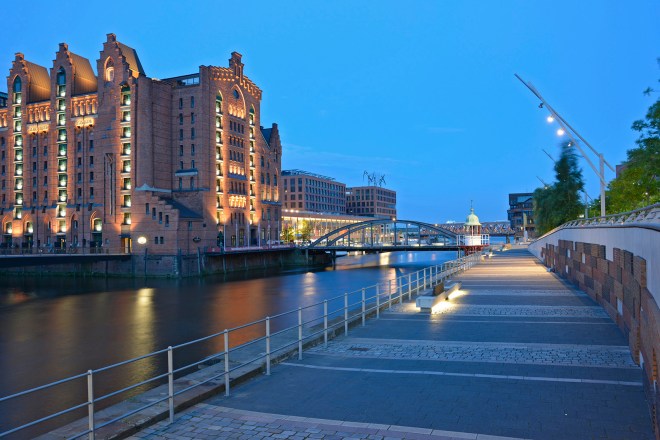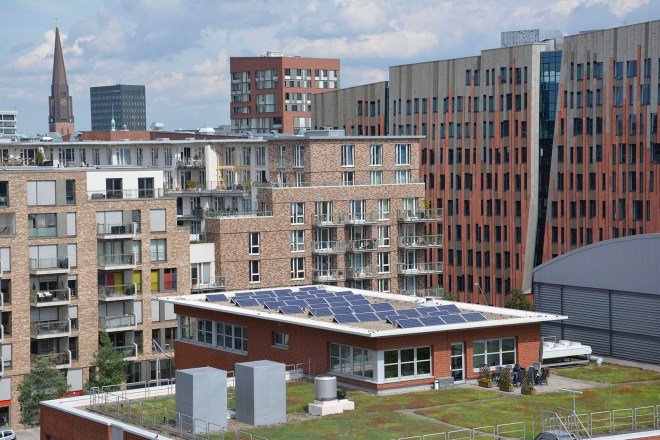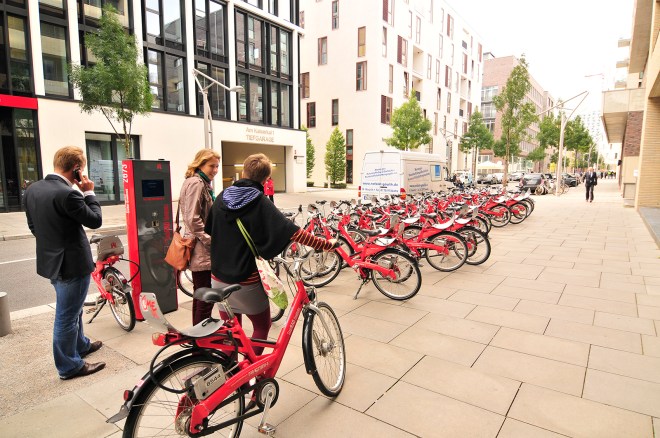Hamburg is a prosperous, fast-growing city. As Germany’s media capital, a hub for tech startups, and home to the headquarters of several major corporations, it attracts around 10,000 new residents a year. And like so many other cities around the world, it doesn’t have enough housing to accommodate all the new residents, which has led to rising prices and a shortage of affordable housing.
But Hamburg is building up its inner core with mixed-use developments in two neighborhoods that had been largely ignored until the last decade: Wilhelmsburg and HafenCity. Both areas have added a lot of new housing and office space. And they have done so in a remarkably green way. The new neighborhoods are intended to carbon-neutral, to produce as much clean energy as they consume, and to be walkable, bikeable, and transit-oriented. But they take two very different approaches, each with its own strengths and weaknesses.
Hamburg’s maritime legacy
Long before it became a tech-friendly 21st century metropolis, Hamburg was a port city. It’s a shipping hub on the tidal Elbe River, a fact that is central to the city’s past and present, defining its history as well as its current-day geography and character. The famous red light district emerged during the days of sailors rolling into town on shore leave. The bars have nautical-themed names and paintings on the exterior walls. The public squares feature statues of sailors the way most European cities honor soldiers or past kings. In Berlin, Germany’s largest city, shipping containers are used for pop-up art galleries and bars. In Hamburg, the second-largest, they are used for shipping.
But the port is no longer geographically central to Hamburg. In the 1960s and ‘70s, containerization revolutionized the shipping industry and required moving the active port from its central historic location to new areas on the city’s perimeter that could accommodate larger ships. Hamburg was left with largely derelict warehouses in HafenCity, an island right across a short bridge from the heart of downtown.

Aerial view of HafenCity.Fotofrizz
Wilhelmsburg, a larger island to the south of HafenCity, was also hit hard by the port’s move. It had historically housed docks and dockworkers, but the workers began to leave, especially after a storm surge in 1962 left 200 people dead. Farther from downtown — it is connected by long tunnels rather than short bridges — Wilhelmsburg is now sparsely populated. It does not appear on tourist maps, and my Airbnb host in Hamburg had never heard of it. With crime and high-school dropout rates around twice the citywide average, Wilhelmsburg is Hamburg’s most troubled quadrant. (Der Spiegel, Germany’s equivalent of Time magazine, dubbed it “the Bronx of Hamburg,” although its crime and graduation rates would actually be the envy of the Bronx.)
And so the Hamburg city government has embarked on a project to solve two simultaneous problems: how to make better, livelier use of these islands and how to provide more housing. It created two independent nonprofits to manage the projects in Wilhelmsburg and HafenCity.
Wilhelmsburg
Wilhelmsburg is, despite its name, not the Williamsburg of Hamburg, although it might resemble its homonymous Brooklyn cousin circa 1995. Even as the mostly working-class area has lost dockworkers and their families, it has welcomed waves of immigrants seeking work from poorer countries in Europe like Poland and Portugal, and now from the Middle East and Turkey. On a commercial street, a store with a sign in Turkish sits next to a Bulgarian/Polish grocery. Gentrification is confined to the cutest quadrant, where pre-war apartment buildings with low rents have started to attract graduate students and nonprofit employees.
My tour guide, Johannes Robert, is an urban planning graduate student who lives in the neighborhood. “When I say I live in Wilhelmsburg, people ask, ‘What happened in your life that you have to live here?’” Robert says. “People have an image of Wilhelmsburg as an area you don’t want to live in, you don’t want to be at night.”
In 2001, the community convened a conference with more than 100 residents to discuss what they wanted for the area’s future. That led to a 2002 white paper calling for a host of improvements such as building high-quality new housing and replacing brownfields with new developments or parks. The government of Hamburg created the IBA Wilhelmsburg, a quasi-governmental local development corporation charged with enhancing the area’s livability and sustainability while building new housing. IBA stands for International Building Exhibition, which took place in Hamburg from 2006 to 2013, with Wilhelmsburg’s revitalization as its biggest project. The idea was to focus international attention, resources, and architectural talent on the project and develop it as a showcase of sustainable development. The IBA Wilhelmsburg organization continues to run the ongoing development project and it still has a public welcome center with a scale model of the island.

IBA Hamburg GmbH / Johannes Arlt
Wilhelmsburg had been left with some problematic legacies of its port era, such as a federal highway that ran through it like a surgical scar, separating the waterfront from the majority of the residential areas and polluting the local air. After the IBA set to work, the highway was moved into an abandoned rail track. A park that had been split in two was reunited, and so was the neighborhood and its waterfront.
There are three main, overlapping components of the effort to make Wilhelmsburg more eco-friendly and energy independent: improving the quality and connectivity of parks and public spaces, building energy-efficient new housing, and generating renewable electricity on-site. A centerpiece of that effort is Energy Hill, a former waste dump that closed in the 1980s. The landfill created a steep hill that had been fenced off and not put to use. IBA turned it into a park, open since 2013, with a viewing platform encircling the peak, which is the highest point in the city. The hill is used for everything from concerts and yoga classes to bicycling contests and a temporary summertime water slide. Being so elevated also means it is a natural spot for wind turbines and solar panels, so IBA installed enough to provide electricity for 4,000 homes.
Nearby, the Energy Bunker, a World War II air raid bunker that stood empty for decades, has been converted into a green power plant. It takes advantage of the extra-thick walls to create an indoor warm water reservoir, fed by a nearby geothermal plant, to heat 3,000 nearby homes. The rooftop has solar installations and a new cafe with panoramic views.

The Energy Bunker in Wilhelmsburg.Geoff Dude
IBA has so far created a total of 5,500 new units of housing, mostly “social housing,” which is the German term for affordable public housing. So, rather than merely accelerating gentrification, as many urban improvement efforts often do, IBA has ensured ongoing economic diversity. The buildings experiment with a range of green building practices. Most are built to “passive house” standards or better. One has heat and energy provided by solar thermal installations on the roof, photovoltaic cells in the glass facade, and vertical gardens of climbing plants along parts of the exterior to reduce heat in the summer. Another has a “solar curtain” of moveable solar panels that can rotate to catch the sun and produce energy or get out of the way of a resident’s window view.
While IBA Wilhelmsburg is undoubtedly a green project, it’s not necessarily a terribly urban one. Everything is spread out. There are buses and bike paths, but not a ton of pedestrian vitality on display. (Admittedly it was a rainy day when I visited.) The new buildings are Modernist. They have idiosyncratic shapes such as wavy walls, and irregular window patterns. One is on stilts with cars parked under the building at ground level. They are often set back from the street, usually behind grass, they are spaced apart.
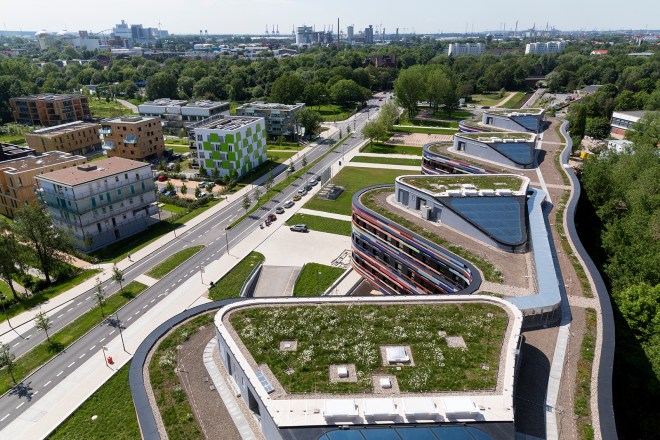
IBA Hamburg GmbH / Bernadette Grimmenstein
The buildings do not create a well-defined, cozy sidewalk that fosters bustling street life; they do not engage the street or feature ground-level retail. Partly, this is intentional on IBA’s part. There were already thriving commercial streets and a market with vendor stalls in a public square that the agency did not want to suck business away from. But the housing still could have been built flush with the street, to better enhance the pedestrian experience.
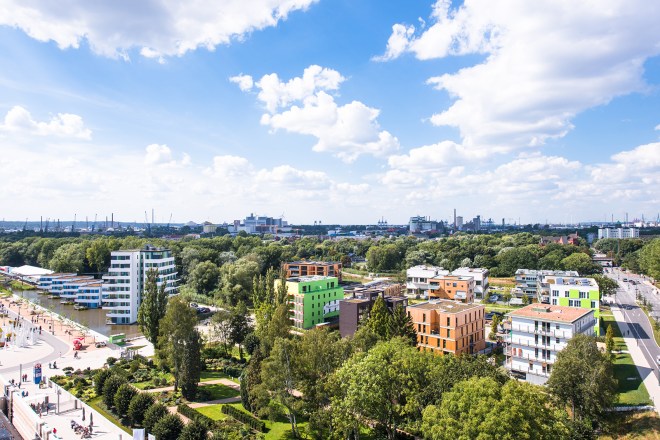
IBA Hamburg GmbH / Johannes Arlt
HafenCity
HafenCity did not repeat those mistakes, in part because it did not have the option to. It is a much smaller island just spitting distance off of downtown. Space was too tight, and the historic architectural surroundings too dominant, to do something as deliberately Modernist as IBA Wilhelmsburg, except at the very far perimeter. Instead, the HafenCity corporation, the nonprofit charged with reinvigorating the area, put in new cobblestone sidewalks and boxy red brick buildings that fit seamlessly with existing buildings in Hamburg’s historic downtown.
“From the 1960s to the ‘90s it was very rundown,” says Andre Stark, a press officer for the HafenCity corporation. “It was just a few stores selling carpets.” But as the city began struggling with a shortage of housing and office space in its adjacent downtown, which was driving up rents, the natural area to expand was the under-utilized old port island. “In the 1990s, the mayor [Henning Voscherau] said, ‘The city will go back to the water,’” says Stark. The HafenCity corporation was founded in 1994. The city bought up the undervalued properties and started selling them to developers, who had to present plans for the purpose and design of their proposed building projects, which then had to be approved by a governing committee with heavy community involvement. The first groundbreaking was in 2001. There are now 2,000 residents, on the way to an ultimate goal of 12,000. Major corporate offices are there, including the headquarters of Unilever and Der Spiegel. HafenCity is intended to be a completely mixed-use district with roughly equal parts housing and commercial space, and abundant ground-floor retail.
But there were some significant logistical challenges. Much of HafenCity lies below the flood zone where, by law, housing in Hamburg cannot be built. The Elbe is a tidal river and flooding is common. It will only become more so with climate change. HafenCity had to be designed to withstand flooding now, and at higher future levels. Building a new dike would have been very expensive, and ultimately risked being overrun anyway.
So an innovative landscaping system was created whereby every building is built on an uninhabited first floor — offices and businesses are allowed, but homes are not — with metal doors that close during floods. Certain streets are also raised. “The old system is to build a rigid dike,” says Stark. “In HafenCity, we give the water space.”
HafenCity also aims to be carbon-neutral, and it does have buildings with rooftop solar panels. One building even has a wind turbine on the roof. Not coincidentally, that’s where Greenpeace Germany has its main office, with an exhibition space on first floor. The group moved there in 2013 after playing a role, as prospective anchor tenant, in the building’s design.
But HafenCity has no Energy Hill or Energy Bunker, and its exterior brick walls are not lined with photovoltaic cells. The buildings are largely powered by natural gas, and to achieve carbon neutrality the buildings buy offsets. The neighborhood does, however, have more park space per capita than the rest of Hamburg or most downtowns. And the parks are well-defined, usually on the waterfront.
Stark argues that the project is overall very eco-friendly. “The whole project is sustainable because it is recycling land in the inner city,” he says. “We tried to create a modern, walkable city, which reduces the use of cars.” There are subway stops on the island, five bike-share stations, and several charging stations for electric cars.
Greenpeace is in partial agreement with Stark: The group would have preferred to see the neighborhood limit cars more aggressively. In response to a query from Grist, it sent an information packet on HafenCity that noted, “The amount of public space that has been created for pedestrians and access to public transportation is definitely very good. However, one drawback is that two four-lane streets have been built. Here Hamburg missed an opportunity to create a district within the city that could have been relatively free of traffic. But in an urban context, the overall conversion of urban wasteland into a district that offers the opportunity to live and work close by was a positive development. The alternative would have been more urban sprawl into outlying areas, creating a much greater dependence on cars and lowering the quality of life.”
The main criticism of HafenCity is that the cost of living is high. When asked about the lack of economic diversity among HafenCity’s residents, Stark suggests that, given high demand to live in the city center, it just isn’t realistic to expect it to house the poor. Stark also notes that the advanced flood resilience measures raise construction costs. Nonetheless, since 2011, every time it sells a new plot for residential development, HafenCity has require one-third of the housing must be affordable.
The differences between the two Hamburg neighborhoods are perfectly embodied by their respective representatives. Robert, my Wilhelmsburg tour guide, is a bearded, shaggy urban planner who works in jeans. He guides guests around on bicycles rented from Hamburg’s bike-share program because the area is too vast to cover efficiently on foot and the IBA project does not own a car. He reflects Wilhelmsburg’s experimental and diverse nature. Stark — representing the HafenCity neighborhood that is more conventionally attractive, dense, and classically urban — is clean shaven, short-haired, and wears a suit. Both men, though, made the case that cities can guide the reclamation of their post-industrial waterfront neighborhoods in ways that have extremely low carbon footprints.
Here in the U.S., where new apartment buildings in cities are often glass monstrosities with terrible energy performance, we could learn a lot from Hamburg.


